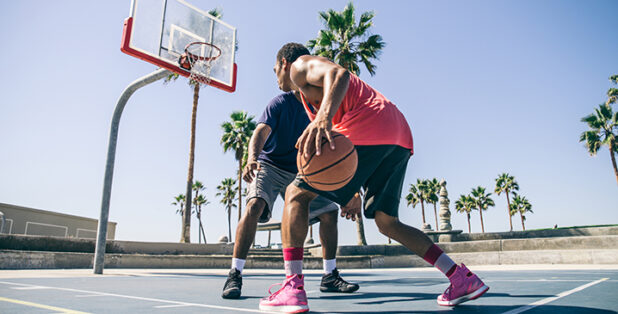When basketball was invented in 1891, it was originally played using a soccer ball and peach baskets. Since then, basketball has undergone an extensive revolution to become one of the world’s most popular sports – played by people of all ages at all skill levels. Between pick-up leagues or just shooting hoops with friends or family, many older adults enjoy basketball recreationally.
Still, basketball is a contact sport and injuries to the ankle, foot, knee, and other joints are common. Sticking an awkward landing or twisting abruptly can cause injury and keep you off the court. Players can also suffer wear-and-tear, thanks to all that dribbling and jumping. To continue playing, it’s important to recognize these risks and do your part to prevent joint injury and pain.
In the spirit of the March basketball tournament, we’ve selected some basketball “safety” tips to share. Check out our tips below to help protect your joints and keep you in the game longer.
- Consult your doctor before playing. Do you want to join a local basketball league but you’re new to the sport or out of practice? It’s a good idea to check in with your physician first, especially if you have a history of joint pain. Make sure to abide by their recommendations for injury prevention.
- Get in shape. While you may be looking toward basketball as a way to get healthy, experts recommend getting in shape beforehand. If you’ve been inactive for a while, it’s important to slowly progress to playing a contact sport like basketball. Start with strength training or agility exercises to gradually improve your fitness.
- Warm up before you hoop. Going for a jog around the court and taking the time to stretch can makeall the difference in terms of prepping your body and preventing injury. Foam rollers are especially helpful for stretching out and loosening your muscles.
- Take note of your terrain. If you’re not playing on a traditional court, check for bumpy, uneven terrain. The last thing you want is for your basketball dreams to be cut short because you tripped or stepped in a pothole.
- Hydration is your best friend. Staying hydrated helps reduce joint inflammation and it’s important to avoid dehydration while being active. If you’re playing basketball, don’t just wait until halftime or after you’re parched to grab a drink. Make sure you’re drinking water consistently.
- Stretch after the game. You finished playing, now what? Take some time to cool down with stretches like these that will help ensure you recover properly.
- Pain means stop. While this may seem like obvious advice, many players overlook or ignore pain. If your joints are hurting, take that as a sign that your body is telling you to stop. Listening to your body is one of the best ways to avoid injuries from overuse.
The good news? While basketball might pose a risk for the lower half of your body, it’s easier on the arms, shoulders, elbows and wrists than other sports that require more overhead throwing like baseball.
At Anika, we’re proud to help patients return to the activities they love. Check out our success stories to hear from patients like Ron, who was able to play basketball again thanks to Anika’s ToeMotion implant.
If you love basketball and joint pain is keeping you away from the court, use our Find a Doctor tool to locate an expert in your area to explore treatment options.
###

